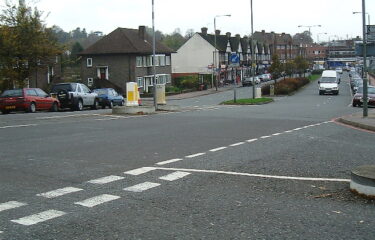TRANSYT is a software suite containing a macroscopic traffic model, a signal optimiser, and a simulation model for the purpose of designing, evaluating and modelling everything from single isolated road junctions to large mixed signal-controlled and priority control traffic networks.
Why use TRANSYT?
Signal timings at road junctions have an important effect on levels of traffic congestion, both at the junction itself and at surrounding junctions which may be signalised or priority-controlled. Ensuring traffic signals are timed effectively is one of the most cost-effective methods for reducing congestion.
Based on decades of research and development, TRANSYT is a now a comprehensive global product used for optimising traffic signals at single junctions and large traffic networks of mixed control. It is designed specifically to give quick solutions with minimal user input, and also more considered solutions when needed.
TRANSYT modelling can feed into many processes – Its signal plans used for fixed time signals; cableless linking facilities; SCOOT base timings; vehicle actuation maximum timings and also used to predict the performance of the aforementioned.
Furthermore, through the addition of a simulation model, TRANSYT’s capability is extended to include the modelling of non-cyclic signalling scenarios, including actuated traffic control.
International use
TRANSYT is suitable for drive-on-the-left and drive-on-the-right conditions. TRANSYT also has a number of features to extend its appropriateness in different countries, such as TRANSYT’s alternative Chilean traffic model, SCATS® split times, turn-on-red flow and alternative user-interface terminology.
Current Version: 17.0.1
System Requirements
Windows 10 or later
Supported Browsers (Portal only)
Google Chrome (latest version)
Mozilla Firefox (latest version)
Microsoft Edge (latest version)
Order Online
| TRANSYT 1 User- 1 Year Subscription | £836.00 | |
| TRANSYT Student Version | £95.00 |
*Cost excludes VAT. Discounts apply in certain circumstances. Please contact us to find out more
Suggest a feature
Who uses TRANSYT?
TRANSYT is used across the globe by traffic engineers, traffic modellers, junction designers, students and tutors, working for local authorities; municipal, state and regional authorities; consultancies of all sizes from multi-nationals to the smallest businesses; universities; other educational establishments.
What can TRANSYT model?
TRANSYT can model mixed networks of signalised and unsignalised junctions. Furthermore, when used in conjunction with a Junctions licence, it has the capability to predict the performance of priority junctions using standard ARCADY PICADY geometric data.
The core traffic model calculates a baseline Performance Index (an economic cost based on stops and delays) using manually entered traffic flows. TRANSYT then runs an optimisation process that adjusts the signal timings with the ultimate aim of reducing the Performance Index (PI) to a minimum. The TRANSYT optimisers are therefore seeking to produce multi-directional ‘green waves’ – a task that is impractical to attempt manually due to the complexity of trying to satisfy multiple objectives from different parts of the network. Green waves on key routes can be easily favoured by applying constraints on the optimiser in the form of weightings and penalties.
A number of optimisers are provided and offer a choice between fast and highly-efficient modelling and slower modelling options which are able to provide better optimised timings. The optimisation process can be influenced by the application of a variety of weighting factors and limit penalties, which allows you to ensure the results match your exact criteria.
The simulation model provides a mechanism to evaluate the performance of a TRANSYT network for a given set of signal timings, for a wider variety of scenarios, including intermittent stages (i.e. non cyclic behaviour), blocking back, uneven lane usage, complex signalled approaches and controller streams on different cycle times. This is achieved by modelling the random arrival patterns of individual vehicles over a series of trials, with results collated from the output of all the trials.
- Evaluate performance of existing layouts and signal timings and investigate future scenarios
- Producing timings to prioritise specific traffic types, such as buses or trams.
- Model multiple scenarios of peak traffic flows and associated signal strategies within one file
- Model signalised, partially signalised and priority roundabouts within one file
- Extensive control of flow allocation process
- User Equilibrium (UE) Assignment of flows
- Stage-based and phase-based optimisation
- Choice of optimisers to establish multi-directional ‘green waves’
- Comprehensive set of options to control the optimisation process in order to maximise the performance of corridors
- Simulation model for evaluating the performance of a wider variety of scenarios, such as:
- demand-dependant scenarios, such as intermittent stages
- explicit modelling of blocking back issues
- explicit modelling of complex signalled approaches
- modelling of basic or optimised actuated traffic control
- modelling of pedestrian crossings (unsignalled and signalled)
- uneven lane usage
- controller streams running on different cycles
- Modelling of short bays
- Model repeated greens or multi-cycled streams
- Modelling of time-varying flow conditions
- Unique London-based walk-on-red pedestrian behaviour model
- Cycle time optimisation
- Interactive diagram / synced data entry screens
- Fast data-entry, including various auto-calculated data items derived from scaled diagram
- Graphical lane-flow overlays for ensuring optimum junction layout and lane designation
- Combined flow/queue animation of vehicular traffic and signalised pedestrian crossings.
- Library files provided to ensure a quick junction setup and to illustrate modelling opportunities
- Auto-calculation of conflicts and inter-greens
- Auto-calculation of RR67 saturation flows
- Customisable performance analysis graphs
- Multiple analysis set and demand flow set system
- Network animations shown for whole modelled period (Simulation Mode)
- Animation showing estimated positioning of individual vehicles, vehicle detections, and green extensions (Simulation Mode)
- 3D visualisation of your network, with a saveable fly-through
- Automated audit-trail facility
- Bath run facility
- One-click production of publication-ready reports
- Report export to PDF or Word format
- PDF user guide that guides you through all aspects of the product
- Runs on the latest Windows platforms
- Files originating from previous versions (TRANSYT 10 onwards), can be imported and re-analysed
- Import TRANSYT 7 SET and TRANSYT 7F files
- Import TRANED 2 files for more advanced modelling
- SCOOT traffic flow messages can be imported into TRANSYT 14 (and above) to utilise live and up-to-date traffic flows
- Import SCATS traffic flow data (including from SCATS ‘dump file’ format) to optimise offsets and signal timings
- Dynamically link to Excel spreadsheet traffic flow data to ensure error-free import
- The transfer of data from Junctions to TRANSYT is provided via an “Export to TRANSYT” option within Junctions
Why upgrade to TRANSYT 17?
TRANSYT 17 includes a simulation model, derived from Junctions 9’s ‘tried and tested’ queue simulation model, extending its capabilities considerably.
Want to know more?
Use Cases
TRANSYT is the ideal modern software for the optimisation of signal timings (and re-timing) for:
- Single isolated signalled or partially signalled junctions
- Fully signalled and partially signalled roundabouts
- Larger networks (town/city centres)
- CLF linked signals (by locking timings between controller streams)
- Prioritising specific traffic types, such as buses or trams.
TRANSYT’s “Flow Overlays” are a great network diagram mode of operation that will assist you greatly in designing your junctions. It is designed to significantly speed up the time-consuming process of working out lane designations – No need to use external lane-flow design tools.
Evaluation runs in Simulation Mode allow you to evaluate the effect of intermittent stages, and also allows you to investigate the performance of your network throughout the modelled time period, by displaying information-rich graphical animations of the estimated position of individual vehicles.
TRANSYT can be made to produce optimised timings that facilitate the progress of traffic along corridors within multi-directional ‘green waves’.
Several TRANSYT features facilitate the evaluation and optimisation of corridors:
- Apply a combination of weighting factors, such as delay weights to encourage the signals optimiser to reduce the delays to traffic travelling along the corridor
- Apply degree of saturation limits and their associated penalty costs again to produce timings that favour the through movements along the corridor
TRANSYT is the ideal software for evaluating the performance of existing (base case) networks/junctions and impact of proposed developments.
- Store multiple sets of data (and results) representing different flow scenarios or signal plans, for multiple peak periods
- Associate and run multiple demand sets per analysis set (signal plan)
- Optimise timings based on one particular demand set, and then evaluate the others with the same timings – Great for robustness tests.
- Evaluate multiple variations of layouts within the one file, sharing flows and signal data between layouts, e.g. compare signalled, unsignalled, and partially signalled roundabout solutions all within the one file
- Use the assignment model to distribute flows to a wider network, and then have full control over the local flow allocation process. The user control of this process ensures you can set up flows within the network to match existing counts/behaviour.
In addition to its ability to evaluate a wide range of junctions and networks TRANSYT can be used to provide:
- Optimised timings for fixed time signal plans
- Timings for CLF linked signals (by locking timings between controller streams)
- Produce base timings for SCOOT or SCATS
- Produce Vehicle actuation (VA) maximum timings
In addition to its ability to evaluate a wide range of junctions and networks TRANSYT can be used to provide:
optimised timings for fixed time signal plans
timings for CLF linked signals (by locking timings between controller streams)
produce base timings for SCOOT or SCATS
produce Vehicle actuation (VA) maximum timings
TRANSYT can model both basic and optimised actuated traffic control, including high-speed sites, pedestrian actuated signals, and several of the fundamental behaviours of MOVA such as variable minimum green times, pre ‘end-of-saturation’ green extensions, and junction-wide delay minimisation related green extensions. Furthermore, oversaturation is detected and its extent is also reported. An animated “Signals Log” allows signal controller behaviour to be tracked throughout the modelled period.
TRANSYT can import SCATS traffic-flow data for the purpose of optimising offsets and signal timings, including from the SCATS ‘dump’ file format. Likewise, SCOOT traffic flow messages can be imported to utilise live and up-to-date traffic flows.


